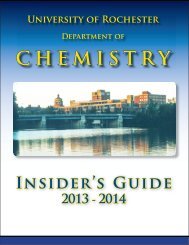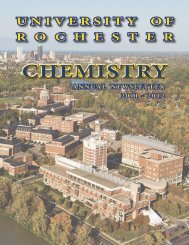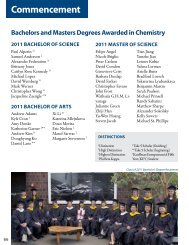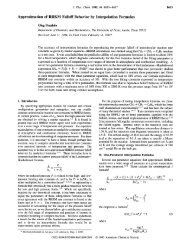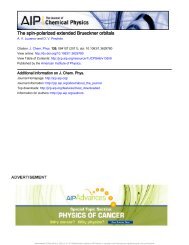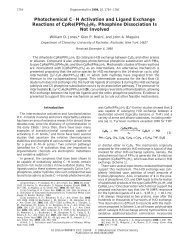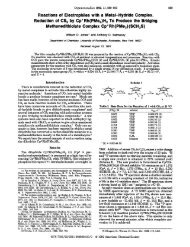Organometallics 2010, 29, 2430â2445 - Chemistry - University of ...
Organometallics 2010, 29, 2430â2445 - Chemistry - University of ...
Organometallics 2010, 29, 2430â2445 - Chemistry - University of ...
Create successful ePaper yourself
Turn your PDF publications into a flip-book with our unique Google optimized e-Paper software.
Article <strong>Organometallics</strong>, Vol. <strong>29</strong>, No. 11, <strong>2010</strong> 2431<br />
spectrum, assigned to the ortho and meta protons <strong>of</strong> the η 2 -C,C<br />
adduct. These observations suggest rapid equilibrations <strong>of</strong> isomers<br />
A2, A3, A4,andA5 (eq 3). As the temperature <strong>of</strong> the sample<br />
increased to -20 °C, the η 2 -arene complexes completely disappeared,<br />
leaving only A1. When the temperature reached 60 °C, a<br />
new set <strong>of</strong> doublets appeared in the 31 P{ 1 H} spectrum that<br />
belonged to the C-CN activation product A6. When the mixture<br />
was cooled back to room temperature, none <strong>of</strong> the η 2 -arene<br />
complexes were observed to reappear in the NMR spectrum<br />
(Supporting Information, Figure SI-1).<br />
Figure 1. ORTEP drawing <strong>of</strong> [Ni(dippe)H] 2 . Ellipsoids are<br />
shown at the 50% probability level. Selected bond lengths (Å):<br />
Ni(1)-Ni(1)A, 2.3737(5); Ni(1)-H(1), 1.64(6); Ni(1)-H(2),<br />
1.51(7); Ni(1)-P(1), 2.1<strong>29</strong>1(6); Ni(1)-P(2), 2.1212(6). Selected<br />
angles (deg): P(1)-Ni(1)-P(2), 91.78(2); P(2)-Ni(1)-Ni(1)A,<br />
136.28(2); P(2)-Ni(1)-H(1), 106(2); H(1)-Ni(1)-H(2), 76(3).<br />
were undertaken to examine the energetics, intermediates,<br />
and reaction pathways <strong>of</strong> the C-CN bond activation. Again,<br />
it was found that formation <strong>of</strong> an η 2 -arene complex is crucial<br />
prior to C-C bond cleavage. This complex is fluxional and<br />
can exist as a stable species in reactions with polycyclic<br />
aromatic nitriles. The transition states leading to C-CN<br />
oxidative addition products showed very similar geometries<br />
to that seen for PhCN, 7 but an additional fluxional pathway<br />
has been identified.<br />
Results and Discussion<br />
Structure <strong>of</strong> the [Ni(dippe)H] 2 Complex. The red dimer<br />
[Ni(dippe)H] 2 is readily prepared from the reaction <strong>of</strong> Ni-<br />
(dippe)Cl 2 and LiHBEt 3 . 8 Recrystallization from hexanes<br />
allowed the X-ray structure <strong>of</strong> the nickel dimer to be<br />
obtained (Figure 1). At each Ni center, two P atoms and<br />
one bridging H atom are essentially planar, with the second<br />
bridging H atom out <strong>of</strong> the plane. The twist angle between the<br />
P1-Ni1-P2 and P1A-Ni1A-P2Aplanesis80° and compares<br />
with values <strong>of</strong> 80° in [Ni(dtbpe)H] 2 , 9 63° in [Ni(dcypp)H] 2 , 10 and<br />
75° in [Ni(dippp)H] 2 . 11 The angle between the Ni1-H1-Ni1A<br />
and Ni1-H2-Ni1A planes is approximately 156°. The distance<br />
between the two Ni atoms is 2.37 A˚ , indicating the presence <strong>of</strong> a<br />
Ni-Ni bond between the two formally Ni I centers. The Ni I -Ni I<br />
distances in the other hydride dimers average 2.44 Å.<br />
Reactions with Dicyanobenzenes. The reaction<strong>of</strong> [Ni(dippe)H] 2<br />
with 1,2-dicyanobenzene at -60 °C initially formed both<br />
η 2 -nitrile (A1)andη 2 -arene complexes (eq 2, A2-A5). The major<br />
product A1 showed a pair <strong>of</strong> doublets in the 31 P{ 1 H} NMR<br />
spectrum at δ 62.7 and 73.5 (J P-P = 62 Hz). The minor product<br />
showed a singlet at δ 57.0 in the 31 P{ 1 H} NMR spectrum and two<br />
broad upfield peaks at δ 5.83 (2H) and 6.28 (2H) in the 1 HNMR<br />
(8) Vicic, D. A.; Jones, W. D. J. Am. Chem. Soc. 1997, 119, 10855.<br />
Compare to [Ni(dcype)H] 2 : Jonas, K.; Wilke, G. Angew. Chem., Int. Ed.<br />
Engl. 1970, 9, 312.<br />
(9) Bach, I.; Goddard, R.; Kopiske, C.; Seevogel, K.; P€orschke, K.-R.<br />
<strong>Organometallics</strong> 1999, 18, 10.<br />
(10) Barnett, B. L.; Kruger, C.; Tsay, Y. H.; Summerville, R. H.;<br />
H<strong>of</strong>fmann, R. Chem. Ber. 1977, 110, 3900.<br />
(11) Fryzuk, M. D.; Clentsmith, G. K. B.; Lezn<strong>of</strong>f, D. B.; Rettig, S. J.;<br />
Geib, S. J. Inorg. Chim. Acta 1997, 265, 169.<br />
Upon adding a second equivalent <strong>of</strong> [Ni(dippe)H] 2 to A1,<br />
a new pair <strong>of</strong> broad doublets appeared in the 31 P{ 1 H} NMR<br />
spectrum (C 6 D 6 )atδ 62.0 and 72.5 (J P-P = 70 Hz), which<br />
was assigned to a bis-η 2 -nitrile complex (A7). 6b After sitting<br />
at room temperature for 1 h, a new species (A8) appeared<br />
in the 31 P{ 1 H} NMR spectrum with characteristics <strong>of</strong> two<br />
different Ni centers, each displaying a pair <strong>of</strong> doublets, both<br />
Ni(II) (δ 63.4 and 77.5, J P-P = 25 Hz) and Ni(0) (δ 63.1 and<br />
74.5, J P-P = 71 Hz) within the same molecule, indicating<br />
only one C-CN bond in A7 was cleaved (eq 4). About 50%<br />
A6 was also observed. Single-crystal structures <strong>of</strong> A6 and A8<br />
were obtained as shown in Figure 2.<br />
A computational study was undertaken to examine the<br />
fluxionality <strong>of</strong> the η 2 -arene complexes and the pathway<br />
leading to the C-CN oxidative addition product. The<br />
[Ni(dmpe)] fragment was used as a model <strong>of</strong> the active<br />
species [Ni(dippe)] in the experiment. 12 Initially the ground<br />
(12) Atesin, T. A.; Li, T.; Jones, W. D. J. Am. Chem. Soc. 2007, 1<strong>29</strong>,<br />
7562.




